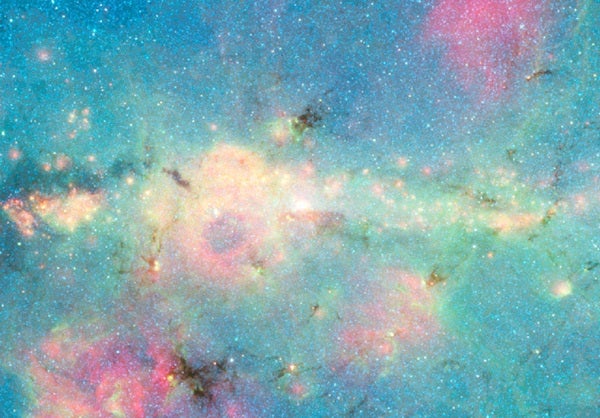A new mosaic of infrared images taken using NASA’s Spitzer Space Telescope gives astronomers a new perspective on our home galaxy. The panoramic view spans 130° along the Milky Way and runs through 13 constellations, from Vulpecula to Centaurus.
Green swaths indicate where stars illuminate organic molecules call polycyclic aromatic hydrocarbons. They often form long arcs as powerful stellar winds from young stars sweep them up. Red patches indicate warm zones of graphite-like dust, and yellow and red dots show where young stars form within their natal clouds. Toward the crowded galactic center, the background turns into a blue-white haze of starlight.
“Looking in infrared light, we can see right across the galaxy,” says Edward Churchwell at the University of Wisconsin-Madison, who led one of the surveys. “It looks entirely different than what we’ve seen before.”
The portrait, unveiled today as a 180-foot poster at the American Astronomical Society meeting in St. Louis, was 5 years in the making. It began with a project called GLIMPSE, for Galactic Legacy Infrared Midplane Survey Extraordinaire. “The E was a bit of a stretch,” jokes team member Robert Benjamin at the University of Wisconsin-Whitewater.
For GLIMPSE, astronomers used the Spitzer Space Telescope to take snapshots along the Milky Way in four infrared wavelengths. Because most of the galaxy’s stars and star-forming regions lie along the galactic plane, there were early concerns that Spitzer’s sensors were too sensitive for such a survey and that most infrared sources would be overexposed. By using exposures of just 2.4 seconds, the GLIMPSE team was able to avoid this problem.
Infrared wavelengths cut through the dense interstellar dust clouds that obscure astronomers’ optical view of the galaxy. Better yet, GLIMPSE reveals previously hidden young stars deep in the hearts of these clouds.
“These dark clouds are the birthing grounds of stars,” says Churchwell, who led the GLIMPSE team. “Nobody understands how star formation is initiated, but we do know a lot about the properties of these clouds.” The galaxy’s coldest, densest, and most-massive clouds are opaque even in the infrared. The GLIMPSE team has cataloged nearly 100 million stars, including many previously hidden within these clouds. Astronomers identified 591 hot bubbles of gas formed by recent star formation and 20,000 stars with dusty envelopes. About 75 percent of those sources are protostars.
To create the portrait, the astronomers combined GLIMPSE data with a complimentary Spitzer survey known as MIPSGAL (for Multiband Imaging Photometer for Spitzer Galactic Plane Survey Legacy), which began in 2005. Led by Carey, MIPSGAL views the galactic plane at two longer wavelengths.
“This picture shows us that our Milky Way galaxy is a crowded and dynamic place.” Carey says. “We have a lot to learn. I’ve definitely found things on this map that I didn’t expect to see.”
The combined panorama includes 800,000 images and 4 billion pixels. A zoomable digital version of the portrait is available here.
According to Churchwell, astronomers weren’t sure dust could survive the intense energy from massive stars found in stellar nurseries. “It turns out dust can survive for several million years. It is much hardier than we thought,” he says. The GLIMPSE and MIPSGAL views of hot and cool dust provide astronomers with new insights into what’s going on in star-forming regions.
The surveys also are providing astronomers with new information about other galaxies. “Galactic astronomers call the Milky Way the galaxy, but extragalactic astronomers call it the ‘zone of avoidance,'” says Benjamin. That’s because external galaxies aren’t visible at optical wavelengths through the dust in the galaxy’s plane. But the GLIMPSE team has identified about 200 galaxy candidates in their data. A study led by Francine Marleau at the Spitzer Science Center confirms that at least 25 of these candidates are previously unidentified galaxies. Her team’s report will appear in a future issue of The Astronomical Journal.
Click here to see a larger view of this image.










